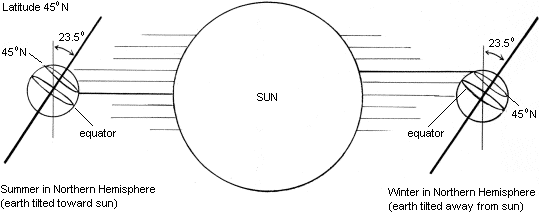Why is the sun less intense in winter than in summer? And, more generally,
what causes the seasons to change? As you can see from the diagram below, the earth's axis
of rotation is not perpendicular to the path of its orbit. The earth is tilted about
23.5° away from vertical.It
takes the earth 24 hours to make one full rotation on this axis, and one full year to
orbit the sun. Summer in the northern hemisphere occurs when the earth's axis of rotation
is tilted toward the sun. However, since the earth's axis of rotation remains fixed
throughout the orbit, when the earth reaches the opposite side of the sun six months
later, the axis is tilted away from the sun. Now it's winter in the northern hemisphere.
But why is the sun less intense? After all, the
distance from earth to sun hasn't changed.*
On the diagram, we've labeled 45° N. This
represents the approximate latitude of Burlington, Vermont; Minneapolis, Minnesota, and
Seattle, Washington. In summer, the sun's rays strike that latitude almost straight on. In
winter, however, the light strikes this region at a sharp angle. Because of this angle,
the sunlight is "spread out" over a larger area, and is therefore less intense
in any one location. (Imagine shining a flashlight at a piece of paper straight on, then
tilting the paper away from the beam. When the light hits the paper straight on, the light
covers a smaller area and is brighter. Tilted, it covers a larger portion of the paper,
but is less intense.)
Another reason the light is less intense is that
it passes through more of the earth's atmosphere—again, because it is striking at an
angle.
Diagram shows 45° N, the approximate latitude of
Burlington VT,
Seattle WA, and Minneapolis MN.

* Technically speaking, the earth's orbit isn't a perfect circle. Rather, it is
slightly elliptical, so that the distance between earth and sun varies. However, this
variation is minor relative to the overall distance, and is not enough to cause the
dramatic changes in day length and seasons.